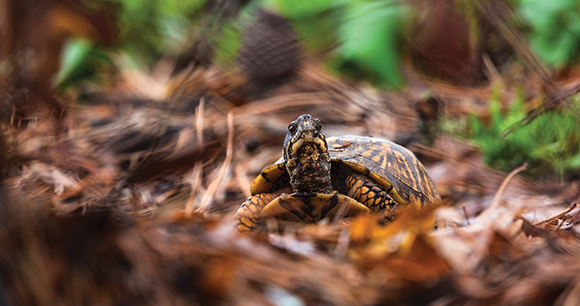by Dr. Tracey D. Tuberville, Ryan J. Rimple, and Emma A. Browning, Savannah River Ecology Laboratory, University of Georgia
The eastern box turtle is collected in enormous numbers for the illegal wildlife trade. Only a portion of this trade is detected, and when it is, wildlife agencies must decide what to do with those animals. Their longevity (40+ years) makes such turtles both challenging to maintain in captivity and extremely valuable to the conservation of wild populations. Illegally collected turtles are often subjected to inhumane conditions prior to their confiscation; thus, supportive care prior to release may be critical to the success of any subsequent repatriation efforts.

With funding from a Christine Stevens Wildlife Award from AWI, we evaluated the suitability of repatriating confiscated box turtles back into the wild using two groups as controls—resident wild turtles and released rehabilitated turtles. In fall 2019, the University of Georgia’s Savannah River Ecology Laboratory, in collaboration with the South Carolina Department of Natural Resources (SCDNR), released more than 150 box turtles confiscated by law enforcement onto a protected site near Aiken, South Carolina, and began monitoring their post-release health, movement, and survival by radio-tracking 40 of the released turtles. As a control, we added 10 wild resident turtles to the study as they were encountered at the release site. We also obtained 35 rehabilitated box turtles that had been surrendered to the SCDNR to conform to new state laws limiting the number of native turtles that citizens can keep in captivity; 26 of this latter group were radio-tracked following their release onto the site. All three groups were monitored during the 2021 field season—the second year post release for confiscated turtles and the first year post release for the long-term captives.
On average, confiscated box turtles took approximately 4-6 weeks following release to settle into the release site and establish a home range. Once they did so, they exhibited movement patterns that were remarkably similar to those of resident box turtles at the same site. On average, confiscated turtles and resident turtles had the same home range sizes and degree of home range reuse from one year to the next. The primary difference was in their activity patterns—confiscated turtles exhibited more variability of movement compared to resident turtles.
Radio-tracked confiscated turtles (who received limited supportive care prior to release) experienced lower survival in the first year following release (60–65%), likely due in part to their lower body condition at the time of release and the stressful conditions they experienced prior to being seized by law enforcement. In the second year, however, the survival rate of confiscated turtles was on par with that of the residents (95–100%).
Our results suggest that if disease risks can be minimized and health at time of release improved, confiscated eastern box turtles can be successfully released back into the wild and behave and perform similarly to resident turtles. Preliminary results from long-term captives lend further support to the important role of release condition on post-release fate, as long-term captives experienced ~90 percent survival during their first year after release. Thus, rehabilitation prior to translocation, thereby enhancing the turtles’ health upon release, may result in greater success for turtles confiscated from the illegal wildlife trade.
Theses and Publications
Browning, E.A. 2022. Investigating the suitability of releasing confiscated eastern box turtles (Terrapene carolina carolina) back into the wild. M.S. Thesis, University of Georgia. 112 pp.
Rimple, R.J., M.T. Kohl, K.A. Buhlmann, and T.D. Tuberville. Post-release dispersal and space use of soft- and hard-released long-term captive eastern box turtles (Terrapene carolina carolina) relative to sympatric resident turtles. In preparation for a Special Issue of Northeastern Naturalist.